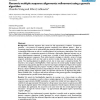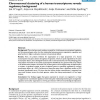126
click to vote
BMCBI
2005
15 years 27 days ago
2005
Background: The extensive use of DNA microarray technology in the characterization of the cell transcriptome is leading to an ever increasing amount of microarray data from cancer...
118
click to vote
BMCBI
2005
15 years 27 days ago
2005
Background: Predicting the subcellular localization of proteins is important for determining the function of proteins. Previous works focused on predicting protein localization in...
115
Voted
BMCBI
2005
15 years 27 days ago
2005
Background: Single nucleotide polymorphisms (SNPs) provide an important tool in pinpointing susceptibility genes for complex diseases and in unveiling human molecular evolution. S...
95
Voted
BMCBI
2005
15 years 27 days ago
2005
Background: Genomic sequence data cannot be fully appreciated in isolation. Comparative genomics
133
click to vote
BMCBI
2005
15 years 27 days ago
2005
Background: Normalization is a basic step in microarray data analysis. A proper normalization procedure ensures that the intensity ratios provide meaningful measures of relative e...
BMCBI
2005
15 years 27 days ago
2005
Background: The allele frequencies of single-nucleotide polymorphisms (SNPs) are needed to select an optimal subset of common SNPs for use in association studies. Sequence-based m...
111
click to vote
BMCBI
2005
15 years 27 days ago
2005
Background: The currently used kth order Markov models estimate the probability of generating a single nucleotide conditional upon the immediately preceding (gap = 0) k units. How...
BMCBI
2005
15 years 27 days ago
2005
Background: Phylogenetic footprinting is the identification of functional regions of DNA by their evolutionary conservation. This is achieved by comparing orthologous regions from...
114
click to vote
BMCBI
2005
15 years 27 days ago
2005
Background: There has been much evidence recently for a link between transcriptional regulation and chromosomal gene order, but the relationship between genomic organization, regu...
108
click to vote
BMCBI
2005
15 years 27 days ago
2005
Background: Good statistical models for analyzing and simulating multilocus recombination data exist but are not accessible to many biologists because their use requires reasonabl...




